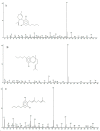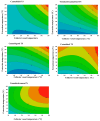Selective Extraction of Cannabinoid Compounds from Cannabis Seed Using Pressurized Hot Water Extraction
- PMID: 32183432
- PMCID: PMC7144126
- DOI: 10.3390/molecules25061335
Selective Extraction of Cannabinoid Compounds from Cannabis Seed Using Pressurized Hot Water Extraction
Abstract
Phytochemicals of Cannabis sativa mainly for the use in the different industries are that of delta-9-tetrahydrocannabinol (THC) and cannabidiol (CBD). Pressurized hot water extraction (PHWE) is seen as an efficient, fast, green extraction technique for the removal of polar and semi-polar compounds from plant materials. The PHWE technique was applied to extract cannabinoid compounds from Cannabis sativa seed. Response surface methodology was used to investigate the influence of extraction time (5-60 min), extraction temperature (50-200 °C) and collector vessel temperature (25-200 °C) on the recovery of delta-9-tetrahydrocannabinol (THC), cannabinol (CBN), cannabidiol (CBD), cannabichromene (CBG) and cannabigerol (CBC) from Cannabis sativa seed by PHWE. The identification and semi quantification of cannabinoid compounds were determined using GCXGC-TOFMS. The results obtained from different extractions show that the amount of THC and CBN was drastically decreasing in the liquid extract when the temperature rose from 140 to 160 °C in the extraction cell and the collector's vessel. The optimal conditions to extract more CBD, CBC, and CBG than THC and CBN were set at 150 °C, 160 °C and 45 min as extraction temperature, the temperature at collector vessel, and the extraction time, respectively. At this condition, the predicted and experimental ratio of THCt (THC + CBN)/CBDt (CBD + CBC+ CBG) was found to be 0.17 and 0.18, respectively. Therefore, PHWE can be seen as an alternative to the classic extraction approach as the efficiency is higher and it is environmentally friendly.
Keywords: cannabinoid compounds; pressurized hot water extraction; response surface methodology.
Conflict of interest statement
The authors declare no conflict of interest.
Figures








Similar articles
-
In Situ Decarboxylation-Pressurized Hot Water Extraction for Selective Extraction of Cannabinoids from Cannabis sativa. Chemometric Approach.Molecules. 2021 Jun 2;26(11):3343. doi: 10.3390/molecules26113343. Molecules. 2021. PMID: 34199346 Free PMC article.
-
Kinetics of CBD, Δ9-THC Degradation and Cannabinol Formation in Cannabis Resin at Various Temperature and pH Conditions.Cannabis Cannabinoid Res. 2022 Aug;7(4):537-547. doi: 10.1089/can.2021.0004. Epub 2021 Jun 4. Cannabis Cannabinoid Res. 2022. PMID: 34096805 Free PMC article.
-
Cannabinoid receptor 1 binding activity and quantitative analysis of Cannabis sativa L. smoke and vapor.Chem Pharm Bull (Tokyo). 2010 Feb;58(2):201-7. doi: 10.1248/cpb.58.201. Chem Pharm Bull (Tokyo). 2010. PMID: 20118579
-
Synthetic Strategies for Rare Cannabinoids Derived from Cannabis sativa.J Nat Prod. 2022 Jun 24;85(6):1555-1568. doi: 10.1021/acs.jnatprod.2c00155. Epub 2022 Jun 1. J Nat Prod. 2022. PMID: 35648593 Review.
-
Pitfalls in the analysis of phytocannabinoids in cannabis inflorescence.Anal Bioanal Chem. 2020 Jul;412(17):4009-4022. doi: 10.1007/s00216-020-02554-3. Epub 2020 Apr 14. Anal Bioanal Chem. 2020. PMID: 32285185 Review.
Cited by
-
Evaluation of a Chaotrope and Kosmotrope in the Multivariate Optimization of PHW-ATPE of Solasodine from Leaves of Solanum mauritianum.Molecules. 2022 Aug 29;27(17):5547. doi: 10.3390/molecules27175547. Molecules. 2022. PMID: 36080313 Free PMC article.
-
A Comprehensive Review on the Techniques for Extraction of Bioactive Compounds from Medicinal Cannabis.Molecules. 2022 Jan 18;27(3):604. doi: 10.3390/molecules27030604. Molecules. 2022. PMID: 35163863 Free PMC article. Review.
-
Rapid In Situ Detection of THC and CBD in Cannabis sativa L. by 1064 nm Raman Spectroscopy.Anal Chem. 2022 Jul 26;94(29):10435-10442. doi: 10.1021/acs.analchem.2c01629. Epub 2022 Jul 18. Anal Chem. 2022. PMID: 35848818 Free PMC article.
-
Understanding the Potential of CBD for Health Benefits: An Overview.Curr Drug Discov Technol. 2025;22(3):e060624230799. doi: 10.2174/0115701638305553240529103622. Curr Drug Discov Technol. 2025. PMID: 38847170 Review.
-
Phytocannabinoids: Pharmacological effects, biomedical applications, and worldwide prospection.J Tradit Complement Med. 2023 Aug 26;13(6):575-587. doi: 10.1016/j.jtcme.2023.08.006. eCollection 2023 Nov. J Tradit Complement Med. 2023. PMID: 38020546 Free PMC article. Review.
References
-
- Yoshimatsu K., Iida O., Kitazawa T., Sekine T., Kojoma M., Makino Y., Kiuchi F. Growth Characteristics of Cannabis sativa L. Cultivated in a Phytotron and in the Field. Bull. Natl. Inst. Health Sci. 2004;122:16–20. - PubMed
-
- Li H.-L. The origin and use of cannabis in eastern asia linguistic-cultural implications. Econ. Bot. 1974;28:293–301. doi: 10.1007/BF02861426. - DOI
-
- Cai C., Yu W., Wang C., Liu L., Li F., Tan Z. Green extraction of cannabidiol from industrial hemp (Cannabis sativa L.) using deep eutectic solvents coupled with further enrichment and recovery by macroporous resin. J. Mol. Liq. 2019;287:110957. doi: 10.1016/j.molliq.2019.110957. - DOI
MeSH terms
Substances
LinkOut - more resources
Full Text Sources
Other Literature Sources
Research Materials
Miscellaneous

